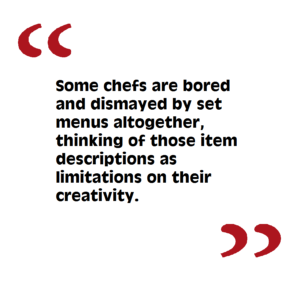Your culinary academy education could take you to a restaurant kitchen where the menu shifts on a near-daily basis or one where the offerings remain untouched for years. As you build a career, it’s important to understand why restaurants take different approaches to menu-building and what makes some changes more successful than others. You may one day find yourself in charge of making these decisions yourself as an executive chef.
The more things change
Restaurants change their menus for a wide variety of reasons. Sometimes it’s simply because certain items prove too difficult to produce consistently or are unpopular with guests.Tyson Ho of New York City’s Arrogant Swine discussed on Serious Eats how he came to realize that turkey legs and corn pone were poor choices for his 
At many restaurants, however, frequent alterations to the menu become a major part of the establishment’s identity. These changes allow chefs to prepare the food that inspires them and use fresh and intriguing ingredients. Farm-to-table restaurants specialize in presenting organically raised local meat and produce with major differences based on the season. For example, at A.R. Valentien’s in La Jolla, California, the spring menu focuses on items like a parsley root soup, smoked salmon with mashed potatoes and buttermilk and chives with a butterscotch pudding dessert.
Constant changes can also add to the sense that meal is a unique culinary experience. This is certainly the case when patrons purchase tickets up to six weeks in advance to dine at Next in Chicago. The courses presented by chef and co-owner Grant Achatz change entirely every few months, each time based on a different theme, time period or geographical location. Some of the past menus have included “Paris, 1906,” “Childhood” and “The Alps.” The Chicago Tribune reported that the “Terroir” menu from 2015 concentrated on wine, inviting patrons to taste about 15 different vintages paired with unique courses like sauteed snails with artichoke puree, pieces of fried basil baguette and snail caviar.
Some chefs are bored and dismayed by set menus altogether, thinking of those item descriptions as limitations on their creativity. Grub Street pointed out that in the earliest restaurants, patrons simply ate what they were served.
Some chefs today have arrived at a similar model. Restaurants like Daniel Burns’ Luksus in New York City or Dan Barber’s Blue Hill at Stone Barns, located 30 miles north of the city, offer several courses of seasonal dishes at a 
The more they stay the same
While an ever-changing menu can make a restaurant exciting, there’s also something to be said for consistency. An institution like the Rainbow Room in New York’s Rockefeller Center bases its reputation on a stubborn refusal to change, down to enforcing an old-school dress code forbidding T-shirts or tennis shoes. An adherence to tradition can be reassuring to diners, who know exactly what to expect whenever they walk through the restaurant’s doors. That means they can return year after year to enjoy a favorite dish.
That formula has paid off for Chicago French-Vietnamese restaurant Le Colonial. The options have remained consistent since opening in 1996 with upscale Southeast Asian-influenced fare like the mi xo do bien, featuring stir-fried shrimp, calamari, scallops, mixed vegetables and pan-fried noodles in a garlic oyster sauce. The restaurant’s director of operations and marketing, Jen Hansen, explained to Forbes why the menu has never changed.
“The Le Colonial concept has stood the test of time and is still a unique experience for our guests,” she said. “Fresh, healthy fare has always been a concept that works.”
Chefs must determine their approach to menu planning based on a number of factors, including their own need for creativity, the equipment and ingredients they have available and the audience they hope to reach. While frequent changes can build intrigue, a comforting, reliable menu has its own rewards. Whether you’re constantly inventing new recipes or perfecting an old favorite, you’ll be able to put the skills you learned in culinary arts programs to work.


